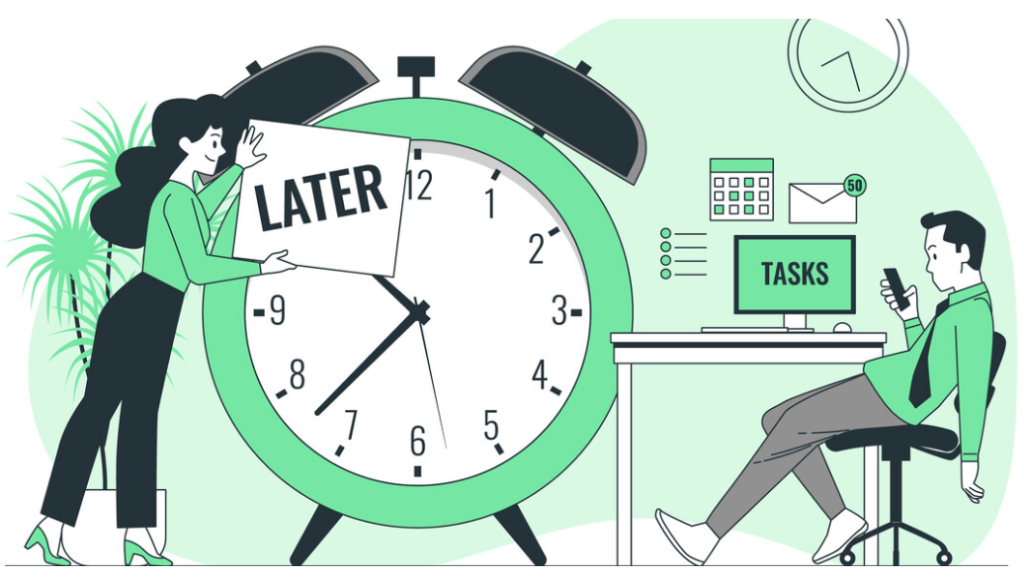
Welcome aboard, weary PhD traveller! You’ve found yourself at “Procrastination Station,” the place where the dissertation doldrums hit hard, and the struggle to stay on task is real. Let’s face it: working on a PhD is a daunting marathon, not a sprint, and while the end goal is rewarding, the day-to-day journey can be a mix of excitement, isolation, and, yes, extreme procrastination. In fact, the prevalence of procrastination among PhD students is nearly universal. Research indicates that 80-95% of college students engage in procrastination to some degree, with about 50% considering it a significant problem (González-Brignardello et al., 2023).
The key problem? Long-term projects like dissertations present the perfect storm for procrastination. Think about it: a dissertation is a massive, often ambiguous project with delayed deadlines, an undefined structure, and few built-in rewards. Each day presents the chance to dive into work—or put it off for “tomorrow,” a day that, as we know, may never arrive. Add in the distractions of modern life (hello, Netflix, Twitter, and a dozen apps begging for attention), and it’s no wonder many find themselves making frequent stops at procrastination’s cozy corner, from “Social Media Siding” to “Netflix Junction.”
Yet procrastination is more than a simple lack of willpower or laziness. Timothy Pychyl, a leading researcher in the field of procrastination, emphasizes that procrastination is largely driven by emotional regulation: we delay tasks as a way of avoiding negative emotions, such as frustration, anxiety, or even boredom, that are tied to specific tasks (Pychyl & Sirois, 2016). For PhD students, this can be especially true; the enormity and uncertainty of dissertation writing service makes it easy to feel overwhelmed. So, instead of diving into a challenging task, we might scroll through Instagram, organize our desks for the third time that day, or decide that now is definitely the best time to clean out the entire fridge.
But here’s the silver lining: some procrastination can actually be productive and even beneficial. Researchers refer to this phenomenon as “structured procrastination,” where individuals accomplish other, often useful, tasks to avoid the most dreaded one (Procee et al., 2013). In fact, John Perry, a philosopher and author of The Art of Procrastination, champions the idea that procrastinators can use this tendency to their advantage by completing smaller tasks to “procrastinate productively” (Perry, 2012). Imagine tackling a section of your dissertation, like qualitative or quantitative methodology, by not working on that specific chapter but instead reading another less intimidating section, like an introduction or discussion section. Essentially, by redirecting that procrastination energy, you’re still making progress—just maybe not in the way you originally planned.
Now, before you get too comfortable with the idea of “productive procrastination,” it’s also worth noting that procrastination, if left unchecked, can have significant downsides. Chronic procrastinators tend to experience higher levels of stress, health issues, and overall dissatisfaction, especially as deadlines draw closer (Tice & Baumeister, 1997). So, while a little procrastination here and there can be harmless or even helpful, excessive delays can lead to a vicious cycle of stress and avoidance, especially when handling tedious writeups like the literature review. As we all know, the looming dissertation deadline is not going to wait forever.
So, what’s a procrastinating PhD student to do? In this blog post, we’re going to look at ways to turn “Procrastination Station” into a productive, creativity-friendly place rather than a dead-end detour. By incorporating fun, research-backed techniques from topic development to journal publication, you can navigate your dissertation journey without falling victim to endless delays. Let’s embark on this adventure with a lighthearted approach to serious productivity. Think of it as a roadmap to avoiding the common “trap stops” and building momentum toward completing your PhD.
Station Stop 1: The Pomodoro “Pasta” Method – Boil Down Your Tasks

Alright, PhD procrastinators, let’s talk about one of the most classic productivity hacks out there: the Pomodoro Technique. But rather than the standard “work in chunks” spiel, let’s spice things up with a kitchen metaphor that any overworked student can relate to. Welcome to the “Pomodoro Pasta Method,” where, like a well-timed pot of pasta, you’re going to cook up focused, manageable blocks of productivity that leave you feeling full and accomplished.
The Pomodoro Technique was created by Francesco Cirillo in the late 1980s and named after the tomato-shaped kitchen timer he used to time his work sessions (hence, Pomodoro, which means “tomato” in Italian). The idea is simple: set a timer for 25 minutes, work on a single task, and then take a 5-minute break. After four “Pomodoros,” take a longer break, around 15–30 minutes (Cirillo, 2018). This technique is a fan-favourite among students and professionals because it helps maintain focus while breaking down intimidating tasks into smaller, digestible chunks.
Why does this method work so well? Research shows that timed, focused work sessions help reduce mental fatigue and increase motivation (Almalki et al., 2020). When we know a break is coming, we’re more willing to commit fully to a task. As each 25-minute interval concludes, we feel a sense of accomplishment that encourages us to start again, preventing the overwhelming “I have to do this for hours” feeling (Mark, Gonzalez, & Harris, 2005). Psychologists also explain that setting a timer provides a mental cue to focus, similar to giving our brains a signal to switch into work mode (Blasche et al., 2017).
The research backs up this approach, too. Studies find that brief breaks, especially those that involve some kind of reward or enjoyable activity, improve focus and productivity over time, as our brains respond well to both structured work and scheduled “micro-rewards” (Ariga & Lleras, 2011). A small reward can also reset motivation by helping to minimize fatigue and renew enthusiasm for the next task.
In a nutshell (or pasta shell, if you will), the Pomodoro Pasta Method keeps your workload manageable and your spirits high. If you can’t seek dissertation help, by boiling your dissertation tasks into these bite-sized pieces, you’re setting yourself up for regular progress without the burn-out of non-stop work sessions. Plus, with every 25-minute session, you’re getting closer to serving up the big dish: a completed dissertation. Bon appétit!
Station Stop 2: Procrasticleaning – The Science-Backed Art of Productive Avoidance
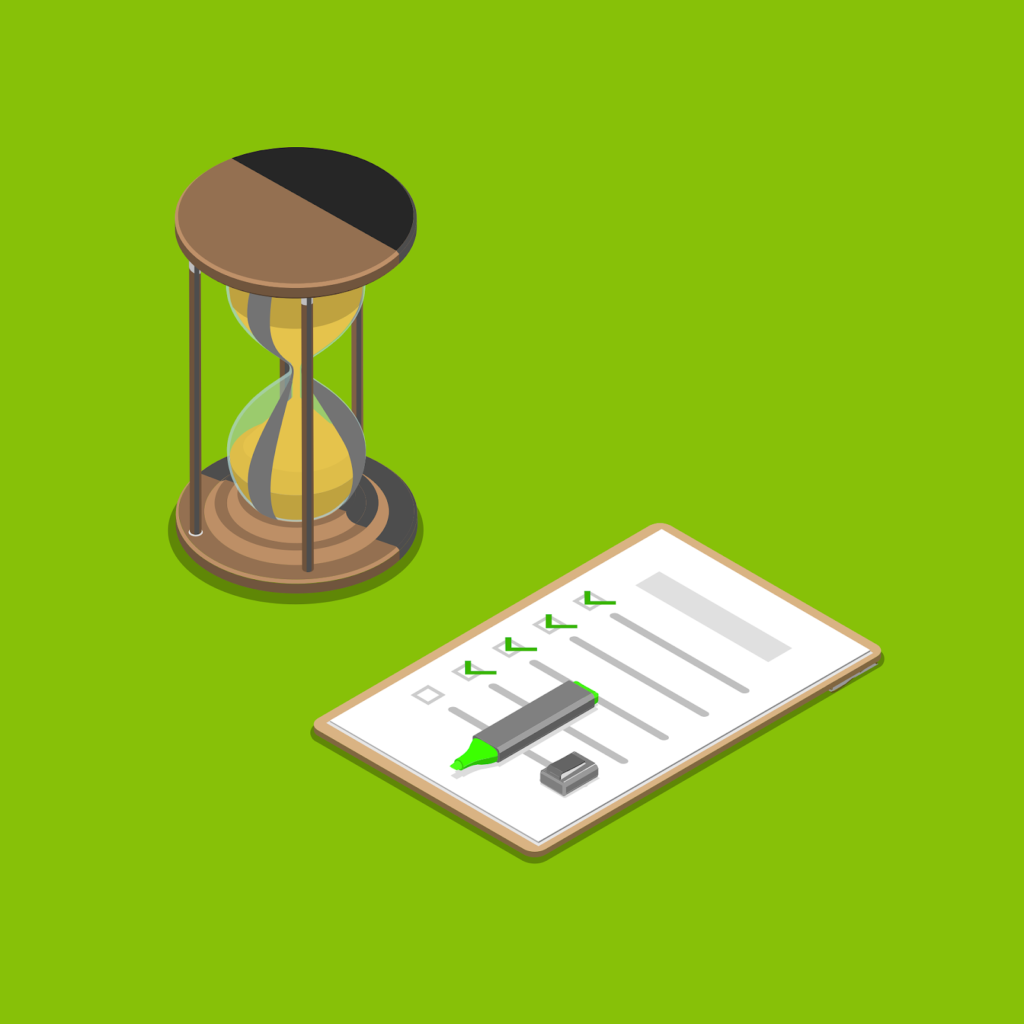
Ah, procrasticleaning: the beautiful, sneaky art of cleaning to avoid that looming dissertation editing or revision. If you’ve ever found yourself reorganizing your entire bookshelf right before a deadline, you’re not alone. Procrasticleaning may sound like a cheeky way to avoid work, but it can actually be an effective strategy for those tough days when writing seems impossible. Rather than spiraling into an endless Netflix binge, procrasticleaning keeps your body moving and your mind active, and, believe it or not, can even help boost your productivity.
So, what exactly is procrasticleaning, and why does it feel so satisfying? When faced with a challenging or overwhelming task, like tackling a huge dissertation section like quantitative or qualitative analysis, many people experience a sense of mental and emotional overload (Moskin, 2018). To cope, we often turn to more manageable tasks that give us a sense of control and completion—enter procrasticleaning. The science supports this approach, too. Studies have shown that cleaning and organizing our spaces can significantly lower stress levels and improve mood. For instance, a study by Darby E. Saxbe and Rena Repetti found that women who described their homes as “cluttered” or “unfinished” had higher levels of the stress hormone cortisol compared to those who felt their homes were more organized and restful (Saxbe & Repetti, 2010). A tidy environment signals calmness and control to the brain, and this shift can create the mental clarity needed to approach complex work tasks, like your dissertation, with renewed focus.
To get the most out of your procrasticleaning, you need to set some clear boundaries. After all, the goal is productive avoidance—you want to feel accomplished without spiraling into an all-day cleaning binge. Here’s how to keep procrasticleaning purposeful:
- Set a Timer: Much like the Pomodoro Technique, setting a timer allows you to focus on a short burst of cleaning without losing track of time. Try 10–15 minutes of light tidying or organizing and then transition back to work.
- Choose Tasks Wisely: Not all cleaning tasks are created equal. Small, repetitive tasks like wiping down your desk, sorting through papers, or arranging books can provide a quick dopamine boost without fully taking you out of work mode. Avoid deep-cleaning projects (like reorganizing an entire closet) that could easily become an all-day affair.
- Create a Clean Workspace: Focus on clearing and organizing your study area. A clutter-free workspace is often associated with improved focus and efficiency (Abebe, 2023), making it a great way to transition from avoidance mode back into productivity mode.
Beyond reducing stress, procrasticleaning can also help resolve that nagging sense of guilt that often accompanies procrastination. When we avoid important tasks, it’s easy to spiral into self-criticism, which only increases stress and makes it harder to focus (Saxbe & Repetti, 2010). However, when we choose a productive distraction, like cleaning, we give ourselves a small sense of accomplishment and relieve some of the guilt, creating a psychological buffer that can reduce the shame-procrastination cycle.
Station Stop 3: The Digital Detox Zone – Unplugging for Productive Focusing
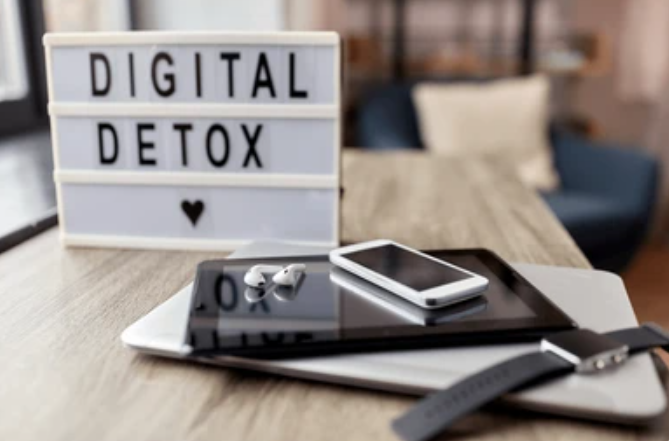
Welcome to the Digital Detox Zone! Picture this: you’re deep into a dissertation section, feeling a rare spark of productivity, when ping—a notification lights up your phone. Suddenly, you’re checking emails, scrolling Instagram, watching dog videos, and spiraling into an endless loop of digital distractions. Sound familiar? The truth is our devices are designed to pull us in, making focus a constant battle. And in the world of academia, where sustained concentration is critical, those constant interruptions can derail even the best-laid plans.
Digital distractions aren’t just a minor nuisance; they’ve become a massive productivity killer. Research shows that each time we’re interrupted by a notification, it takes an average of 23 minutes to fully regain focus (Jung, 2021). In the context of dissertation work, especially in developing quantitative or qualitative methodology, where complex ideas need sustained attention, this disruption compounds the difficulty of getting into a “flow” state. Flow, a term popularized by psychologist Mihaly Csikszentmihalyi, describes that sweet spot where we’re fully immersed and deeply engaged in a task (Csikszentmihalyi, 2014). But for flow to occur, we must avoid distractions long enough to get “in the zone.”
Enter the concept of the “digital detox”—a deliberate break from screens and notifications to create the mental space needed for deep work. Digital detoxing isn’t about banning devices forever; it’s about creating focused, uninterrupted time where technology can’t intrude. Studies confirm that periodic breaks from screens and devices reduce stress, improve cognitive function, and increase focus. In fact, a study published in Organizational Behavior and Human Decision Processes found that time away from devices enhances attention span and creativity by reducing “attention residue” (Leroy, 2009). Here’s how to implement a digital detox into your dissertation routine:
- Set Boundaries with Technology: Put your devices on “Do Not Disturb” or use focus apps to block distracting sites. Even better, leave your phone in another room to reduce temptation. Researchers have found that the mere presence of a phone can lower cognitive capacity, even if it’s turned off (Wilmer et al., 2017), so give yourself a break and keep it out of sight.
- Designate “Screen-Free” Work Blocks: Schedule device-free work sessions—ideally in 30- to 60-minute chunks—to help you ease into deep focus. Start with just one or two sessions per day and build up as you get more comfortable. Over time, these uninterrupted blocks will become a mental cue for productivity, helping you achieve flow more consistently.
- Create a Reward System for Breaks: Let’s be honest; we all love our screens! So, use them as a reward after a focused work session. Research has shown that short, intentional rewards reinforce positive habits, making it easier to replicate productive behaviors (Cheema, 2023). Give yourself a few minutes of social media time or a quick video break as a reward for each “detoxed” study block.
- Find Low-Tech Alternatives for Quick Notes and Ideas: Rather than relying on your phone to jot down ideas, keep a notepad nearby. Writing by hand not only keeps you off your device but has also been shown to improve memory and engagement with the material (Wilmer et al., 2017).
By implementing these detox strategies, you’re creating an environment that supports deeper thinking, reduces the cognitive toll of digital distractions, and builds the mental endurance needed for dissertation work. Remember, the Digital Detox Zone is less about “cutting out technology” and more about “cutting down interruptions.” You’re training your mind to focus and re-engage with complex tasks, a skill that will serve you well beyond your PhD.
In the end, a successful digital detox isn’t about being anti-technology; it’s about becoming pro-focus. When you set intentional boundaries around your devices, you’re empowering yourself to work deeply and meaningfully on your dissertation. So, switch off the notifications, give yourself permission to unplug, and enjoy the focus boost that comes with a well-earned digital break. Your future, distraction-free self will thank you.
Station Stop 4: The Two-Minute Rule – Tiny Tasks with Big Impact
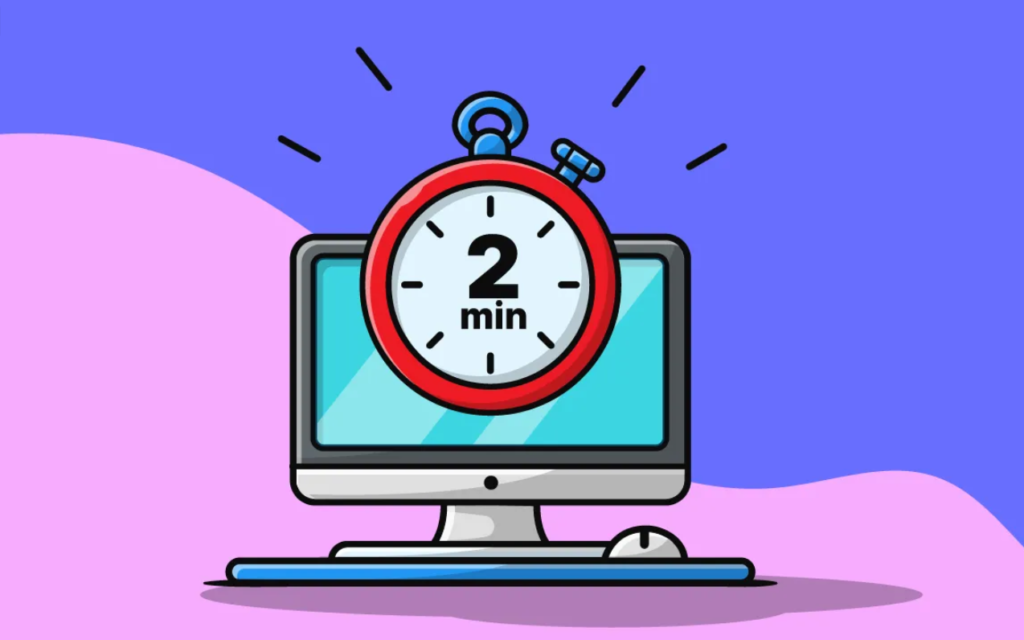
Welcome to Station Stop 4, home of the famous Two-Minute Rule. If you’re deep in dissertation territory, you know the overwhelming feeling that comes with a massive to-do list and a ticking deadline. The Two-Minute Rule, coined by productivity expert David Allen in Getting Things Done, is a simple but powerful way to tackle that sense of overwhelm: if a task takes less than two minutes, just do it right away (Allen, 2001). These tiny, “just-do-it” moments add up quickly, making a noticeable dent in your task list and giving you a steady sense of accomplishment.
The beauty of the Two-Minute Rule lies in its simplicity. By focusing on quick wins, you sidestep the inertia of bigger tasks and prevent decision fatigue, which occurs when we’re overloaded by too many choices (Baumeister, Bratslavsky, Muraven, & Tice, 1998). We may think that only big tasks matter, but the reality is that small tasks often pile up into major roadblocks. For a PhD student, these tasks can include simple things like alignment or reference auditing, backing up a file, replying to an email, or even setting up the next day’s study session. Completing these mini-tasks gives you a hit of dopamine, the brain’s “feel-good” chemical, which can kick-start motivation for larger tasks (Kringelbach & Berridge, 2009).
But what makes the Two-Minute Rule so effective for tackling procrastination? Breaking large projects into small, actionable steps reduces the psychological resistance that often comes with daunting tasks. Research on habit formation shows that small, achievable actions are easier to complete and repeat, which can lead to longer-lasting productivity habits (Wood & Neal, 2007). When you check off small tasks, you not only get an immediate sense of progress but also build momentum for the more time-intensive parts of your dissertation. Here’s how to make the Two-Minute Rule work for you in dissertation mode:
- Start with a Micro-Task List: Each day, jot down a few small, two-minute tasks related to your dissertation. Examples could include organizing your references, outlining a paragraph, or bookmarking relevant research articles. Completing these quickly gives you a psychological “win” that keeps you motivated.
- Use It to Clear Clutter: Small administrative tasks (like backing up files, emailing a supervisor, or organizing your digital workspace) can be tedious but critical. By knocking these out as they come up, you prevent them from becoming bigger distractions down the road.
- Build Momentum for Larger Tasks: The Two-Minute Rule is especially powerful as a “gateway” to bigger projects. Telling yourself, “I’ll just spend two minutes on this section”, can make it easier to start a larger task. Often, getting started is the hardest part, and once you’re engaged, you’re likely to keep going. This technique called the “Zeigarnik Effect,” suggests that starting a task helps keep it active in your mind, making you more likely to finish it (Baumeister & Vohs, 2007).
- Combine with the Pomodoro Technique: Pairing the Two-Minute Rule with timed work sessions can give you a powerful one-two punch for productivity. Use the first few minutes of a Pomodoro session to tackle tiny tasks, clearing mental space before diving into focused work. This combo creates a “clean slate” effect, giving you a productive boost as you transition to bigger tasks.
The Two-Minute Rule may seem deceptively simple, but its impact is anything but small. These quick, manageable tasks keep you moving forward, reducing procrastination by breaking tasks down into their simplest forms. Before you know it, those tiny two-minute victories add up to big gains, taking you ever closer to a completed dissertation. So, the next time you feel that overwhelming weight of your workload, remember the power of two minutes. Tackling even the tiniest task can be the spark that shifts you from avoidance mode into productivity mode. Here’s to making every small action count!
Station Stop 5: “Body Break” Moments – Moving for Mental Rejuvenation
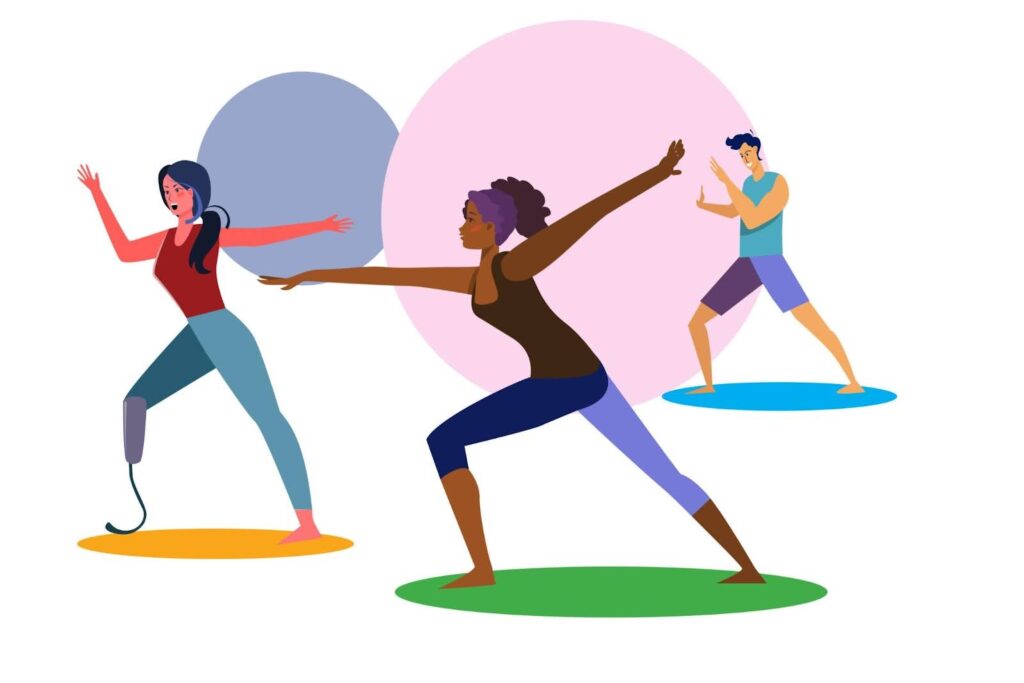
Welcome to Station Stop 5, home of the “Body Break.” This is where we embrace the power of short, intentional movement breaks to rejuvenate the mind and keep dissertation burnout at bay. If you’ve ever found yourself staring at your computer screen, feeling sluggish and uninspired, it may be time to get up, shake it off, and take a body break. While it might seem counterintuitive to step away when facing tight deadlines, science tells us that brief bursts of physical activity can actually sharpen our focus, boost creativity, and improve productivity.
Research backs up the power of movement for mental clarity. Research shows that short breaks involving physical activity reduce stress, enhance mood, and help prevent mental fatigue, especially during cognitively demanding tasks like writing a dissertation (Brazaitis & Satas, 2023). When we exercise, even for a few minutes, our brains release endorphins and other neurochemicals that improve our overall sense of well-being and alertness. Physical activity also increases blood flow, which can enhance brain function and help with memory recall—something every PhD student needs!
One effective way to incorporate these movement breaks is through “micro-exercises” that can be done quickly and don’t require a gym. These are small, simple activities—think stretching, light walking, or even a mini dance session. Research has shown that even short bouts of movement (under 10 minutes) can have cognitive benefits. For instance, a study from Stanford University found that walking boosts creative thinking by 60% as compared to sitting, with the benefits persisting even after you sit back down (Oppezzo & Schwartz, 2014). This means that if you’re feeling stuck or need fresh ideas, a short walk might be just the thing to spark new perspectives. Here’s how to incorporate body breaks into your dissertation routine:
- Set a Timer for Regular Movement: Aim to get up every 45–60 minutes for a quick stretch or movement break. This practice, known as the “active break” strategy, has been shown to help maintain concentration and reduce physical discomfort associated with long periods of sitting (Brakenridge et al., 2022). Use these short breaks to shake off the mental fog and give your mind a chance to reset.
- Try Desk-Friendly Movements: If getting up isn’t feasible, try simple desk exercises. Wrist stretches, neck rolls, shoulder shrugs, and seated leg lifts are all small, subtle movements that can improve circulation and reduce tension without needing a lot of space or time.
- Incorporate Movement as a Reward: Use body breaks as a way to reward yourself after a solid chunk of work. Knowing that a quick dance break or walk outside awaits can serve as a powerful motivator to keep pushing through focused study periods.
- Use Movement to Refresh Creativity: When you’re struggling with writer’s block or a complex argument, a body break can stimulate fresh ideas. As mentioned, walking is particularly effective for creative thinking, so if you’re feeling stuck, a brisk walk around your study space or outside may give you the inspiration you need to tackle that tricky section.
Physical activity’s benefits for cognitive performance are well-documented. A review of studies on exercise and cognitive function suggests that movement improves everything from executive function to memory and processing speed (Oppezzo & Schwartz, 2014). Essentially, incorporating short “body breaks” into your routine not only provides a mental reset but also equips your brain to handle complex tasks with more resilience.
Incorporating body breaks into your dissertation work isn’t just about staying fit; it’s about giving your mind the refresh it needs to stay sharp and focused. As you break up the grind of sitting and staring at a screen with these quick, energizing bursts of movement, you’ll likely find yourself returning to your work with renewed focus and energy. So go ahead, set a timer, get moving, and let the body break magic to help you power through to that PhD finish line.
Final Stop: Celebrating Small Wins – Rewarding Yourself Through the Journey

Congratulations, PhD traveler! You’ve reached the final stop on our productivity tour: Celebrating Small Wins. In the marathon of dissertation writing, it’s easy to get bogged down by the enormity of the project. The finish line can feel miles away, and motivation can wane over time. That’s where celebrating small wins comes in—by breaking up the journey into smaller, achievable milestones and rewarding yourself along the way, you’re not only giving yourself a morale boost but also creating a powerful cycle of motivation and productivity.
Why celebrate small wins? Research shows that recognizing and rewarding incremental achievements can significantly improve motivation and perseverance. According to Teresa Amabile, a professor at Harvard Business School, small wins create a “progress principle,” where each completed step increases our intrinsic motivation to keep going (Amabile & Kramer, 2011). For PhD students, this means that breaking your dissertation into mini-goals, like completing a literature review or writing a rough draft of a qualitative or quantitative methodology, helps sustain momentum through what can otherwise be an endless sea of research and revisions.
One of the reasons small wins are so effective is due to the role of dopamine in our brains. Dopamine, often called the “feel-good” neurotransmitter, is released when we achieve a goal or receive positive feedback, creating a rewarding sensation that reinforces goal-oriented behavior (MD, 2022). By intentionally celebrating small accomplishments, you’re not just boosting your mood—you’re training your brain to associate dissertation work with positive feelings, making it easier to keep pushing through the tough days. So, how can you effectively celebrate small wins during the dissertation editing process?
At the end of the day, celebrating small wins isn’t just about feeling good; it’s about sustaining motivation and building resilience throughout the long, challenging process of completing your dissertation. By giving yourself permission to celebrate the journey—not just the destination—you’re investing in your own success and keeping your mind and motivation healthy for the final stretch.
So, take a moment to pause, celebrate every bit of progress, and give yourself credit for the hard work you’ve done. Dissertation writing is no small feat, and every win, no matter how small, deserves recognition. Here’s to reaching the finish line with a smile—and maybe even a few celebrations along the way.
Conclusion
In conclusion, navigating the dissertation journey is undoubtedly challenging, but as highlighted in this blog, adopting creative, practical, and science-backed strategies can transform the process from overwhelming to manageable—even enjoyable. Procrastination may be a natural inclination, especially for PhD students facing massive, often ambiguous projects, but structured procrastination, productivity techniques, and intentional breaks can help shift this tendency into a productivity tool rather than a pitfall. By seeking dissertation help or exploring dissertation consulting services, students can further support their progress, accessing professional guidance tailored to overcome unique obstacles in the dissertation process.
Whether through adopting techniques like the Pomodoro “Pasta” Method, using procrasticleaning for focused productivity, engaging in digital detoxes, or applying the Two-Minute Rule, each strategy provides students with actionable ways to stay on track. By incorporating professional dissertation assistance, you can also gain help with dissertation planning, organization, and task management, making it easier to address procrastination and focus on productivity.
Each station on this productivity tour emphasizes the importance of balance and mental well-being. From intense focus sessions to intentional body breaks that rejuvenate both mind and body, these methods acknowledge the need for a holistic approach to productivity. Even small steps, like clearing a desk or celebrating incremental wins, can be catalysts for larger achievements, keeping motivation high and building momentum toward the ultimate goal. When combined with dissertation services, these small actions compound, helping students maintain focus and morale.
Dissertation writing is a marathon that requires patience, persistence, and self-compassion. By embracing the strategies in this guide and exploring help with dissertation writing through various dissertation consulting or dissertation assistance options, students can alleviate pressures, avoid burnout, and make each step of the journey more manageable. Remember, each productive action, no matter how small, brings you closer to your goal. Embrace each station, celebrate every small win, and keep pushing forward—the finish line is within reach, one step at a time.
References
Abebe, E. G. (2023). Maximizing Work Efficiency While Working from Home. https://hdl.handle.net/10657/14927
Almalki, K., Alharbi, O., Al-Ahmadi, W., & Aljohani, M. (2020). Anti-procrastination Online Tool for Graduate Students Based on the Pomodoro Technique. In P. Zaphiris & A. Ioannou (Eds.), Learning and Collaboration Technologies. Human and Technology Ecosystems (pp. 133–144). Springer International Publishing. https://doi.org/10.1007/978-3-030-50506-6_10
Amabile, T., & Kramer, S. (2011). The Progress Principle: Using Small Wins to Ignite Joy, Engagement, and Creativity at Work. Harvard Business Press.
Ariga, A., & Lleras, A. (2011). Brief and rare mental “breaks” keep you focused: Deactivation and reactivation of task goals preempt vigilance decrements. Cognition, 118(3), 439–443. https://doi.org/10.1016/j.cognition.2010.12.007
Brakenridge, C. J., Gardiner, P. A., Grigg, R. V., Winkler, E. A. H., Fjeldsoe, B. S., Schaumberg, M. A., Owen, N., Eakin, E. G., Biddle, S. J. H., Moodie, M., Daly, R. M., Green, D. J., Cohen, N., Gray, L., Comans, T., Buman, M. P., Goode, A. D., Nguyen, P., Gao, L., … Dunstan, D. W. (2022). Sitting less and moving more for improved metabolic and brain health in type 2 diabetes: ‘OPTIMISE your health’ trial protocol. BMC Public Health, 22(1), 929. https://doi.org/10.1186/s12889-022-13123-x
Brazaitis, M., & Satas, A. (2023). Regular short-duration breaks do not prevent mental fatigue and decline in cognitive efficiency in healthy young men during an office-like simulated mental working day: An EEG study. International Journal of Psychophysiology, 188, 33–46. https://doi.org/10.1016/j.ijpsycho.2023.03.007
Cheema, H. M. (2023). An Evaluation of Behavior Management Training: Training Teachers to Improve Classroom Management Skills [PhD Thesis, Oklahoma State University]. https://search.proquest.com/openview/10afbad7f2db46a9d066c896321479fb/1?pq-origsite=gscholar&cbl=18750&diss=y
Cirillo, F. (2018). The Pomodoro technique: The acclaimed time-management system that has transformed how we work. Currency.
Csikszentmihalyi, M. (2014). The Systems Model of Creativity: The Collected Works of Mihaly Csikszentmihalyi. Springer Netherlands. https://doi.org/10.1007/978-94-017-9085-7
González-Brignardello, M. P., Paniagua, A. S.-E., & López-González, M. Á. (2023). Academic Procrastination in Children and Adolescents: A Scoping Review. Children, 10(6), 1016. https://doi.org/10.3390/children10061016
Jung, B. (2021). Attention as a scarce resource in the platform economy. In Disruptive Platforms. Routledge.
Leroy, S. (2009). Why is it so hard to do my work? The challenge of attention residue when switching between work tasks. Organizational Behavior and Human Decision Processes, 109(2), 168–181. https://doi.org/10.1016/j.obhdp.2009.04.002
MD, D. G. A. (2022). You, Happier: The 7 Neuroscience Secrets of Feeling Good Based on Your Brain Type. Tyndale House Publishers, Inc.
Moskin, J. (2018). But First, I’ll Bake. The New York Times, D1(L)-D1(L).
Oppezzo, M., & Schwartz, D. L. (2014). Give your ideas some legs: The positive effect of walking on creative thinking. Journal of Experimental Psychology: Learning, Memory, and Cognition, 40(4), 1142.
Perry, J. (2012). The art of procrastination: A guide to effective dawdling, lollygagging, and postponing. Workman Publishing.
Procee, R., Kamphorst, B. A., van Wissen, A., & Meyer, J.-J. (2013). A formal model of procrastination. https://www.academia.edu/download/79322787/download.pdf
Pychyl, T. A., & Sirois, F. M. (2016). Chapter 8—Procrastination, Emotion Regulation, and Well-Being. In F. M. Sirois & T. A. Pychyl (Eds.), Procrastination, Health, and Well-Being (pp. 163–188). Academic Press. https://doi.org/10.1016/B978-0-12-802862-9.00008-6
Saxbe, D. E., & Repetti, R. (2010). No Place Like Home: Home Tours Correlate With Daily Patterns of Mood and Cortisol. Personality and Social Psychology Bulletin, 36(1), 71–81. https://doi.org/10.1177/0146167209352864
Wilmer, H. H., Sherman, L. E., & Chein, J. M. (2017). Smartphones and Cognition: A Review of Research Exploring the Links between Mobile Technology Habits and Cognitive Functioning. Frontiers in Psychology, 8. https://doi.org/10.3389/fpsyg.2017.00605